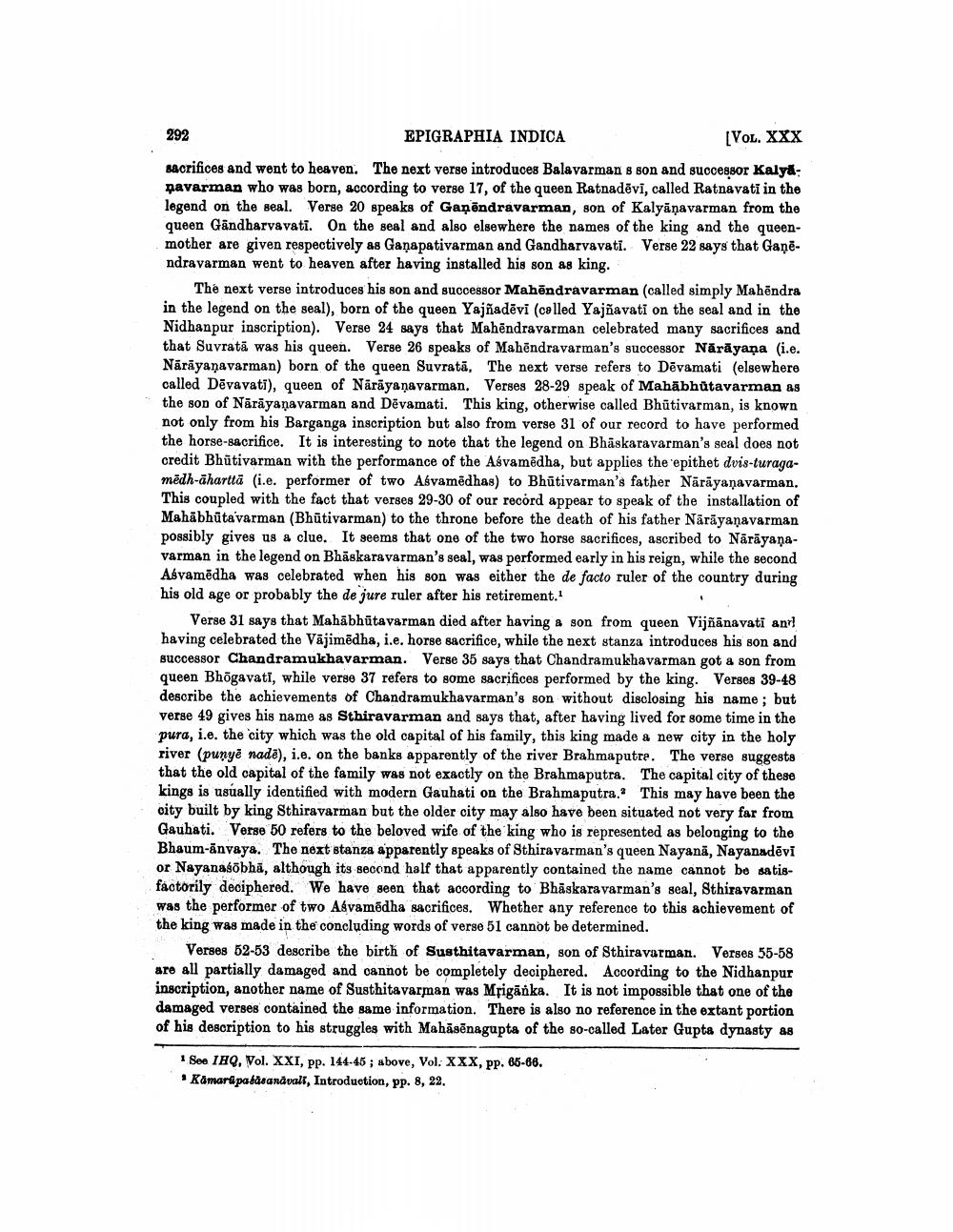________________
EPIGRAPHIA INDICA
[VOL. XXX sacrifices and went to heaven. The next verse introduces Balavarman s son and successor Kalyāpavarman who was born, according to verse 17, of the queen Ratnadevi, called Ratnavati in the legend on the seal. Verse 20 speaks of Ganendravarman, son of Kalyanavarman from the queen Gandharvavati. On the seal and also elsewhere the names of the king and the queenmother are given respectively as Ganapativarman and Gandharvavati. Verse 22 says that Gaņēndravarman went to heaven after having installed his son as king.
292
The next verse introduces his son and successor Mahendravarman (called simply Mahendra in the legend on the seal), born of the queen Yajñadevi (called Yajnavati on the seal and in the Nidhanpur inscription). Verse 24 says that Mahendravarman celebrated many sacrifices and that Suvrata was his queen. Verse 26 speaks of Mahendravarman's successor Nārāyaṇa (i.e. Nārāyaṇavarman) born of the queen Suvrata, The next verse refers to Devamati (elsewhere called Devavati), queen of Nārāyaṇavarman. Verses 28-29 speak of Mahābhutavarman as the son of Nārāyaṇavarman and Dēvamati. This king, otherwise called Bhutivarman, is known not only from his Barganga inscription but also from verse 31 of our record to have performed the horse-sacrifice. It is interesting to note that the legend on Bhaskaravarman's seal does not credit Bhutivarman with the performance of the Aávamedha, but applies the epithet dvis-turagamedh-aharttä (i.e. performer of two Asvamedhas) to Bhutivarman's father Narayanavarman. This coupled with the fact that verses 29-30 of our record appear to speak of the installation of Mahabhutavarman (Bhutivarman) to the throne before the death of his father Nārāyaṇavarman possibly gives us a clue. It seems that one of the two horse sacrifices, ascribed to Nārāyaṇavarman in the legend on Bhaskaravarman's seal, was performed early in his reign, while the second Asvamedha was celebrated when his son was either the de facto ruler of the country during his old age or probably the de jure ruler after his retirement.1
Verse 31 says that Mahābhutavarman died after having a son from queen Vijñānavati an! having celebrated the Vajimedha, i.e. horse sacrifice, while the next stanza introduces his son and successor Chandramukhavarman. Verse 35 says that Chandramukhavarman got a son from queen Bhōgavati, while verse 37 refers to some sacrifices performed by the king. Verses 39-48 describe the achievements of Chandramukhavarman's son without disclosing his name; but verse 49 gives his name as Sthiravarman and says that, after having lived for some time in the pura, i.e. the city which was the old capital of his family, this king made a new city in the holy river (punye nade), i.e. on the banks apparently of the river Brahmaputre. The verse suggests that the old capital of the family was not exactly on the Brahmaputra. The capital city of these kings is usually identified with modern Gauhati on the Brahmaputra. This may have been the city built by king Sthiravarman but the older city may also have been situated not very far from Gauhati. Verse 50 refers to the beloved wife of the king who is represented as belonging to the Bhaum-anvaya. The next stanza apparently speaks of Sthiravarman's queen Nayana, Nayanadēvi or Nayanasōbha, although its second half that apparently contained the name cannot be satisfactorily deciphered. We have seen that according to Bhaskaravarman's seal, Sthiravarman was the performer of two Asvamedha sacrifices. Whether any reference to this achievement of the king was made in the concluding words of verse 51 cannot be determined.
Verses 52-53 describe the birth of Susthitavarman, son of Sthiravarman. Verses 55-58 are all partially damaged and cannot be completely deciphered. According to the Nidhanpur inscription, another name of Susthitavarman was Mriganka. It is not impossible that one of the damaged verses contained the same information. There is also no reference in the extant portion of his description to his struggles with Mahāsēnagupta of the so-called Later Gupta dynasty as
1 See IHQ, Vol. XXI, pp. 144-45; above, Vol. XXX, pp. 65-66.
3 Kamarüpabasanavali, Introduction, pp. 8, 22.




